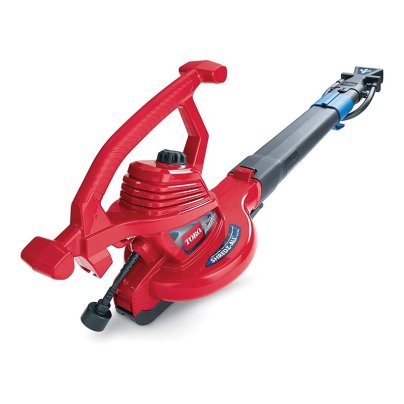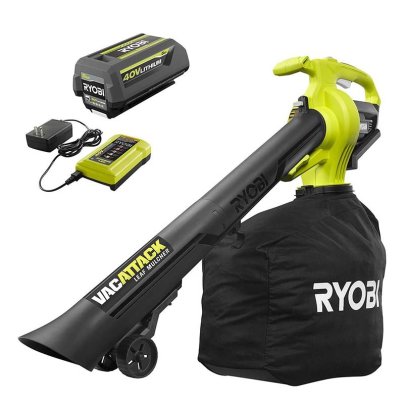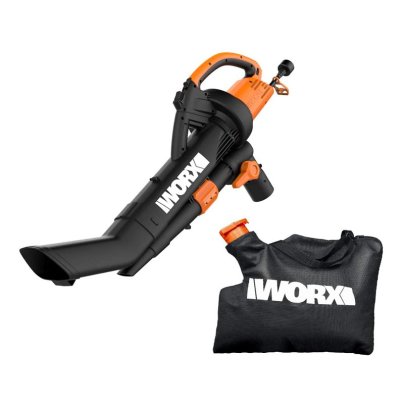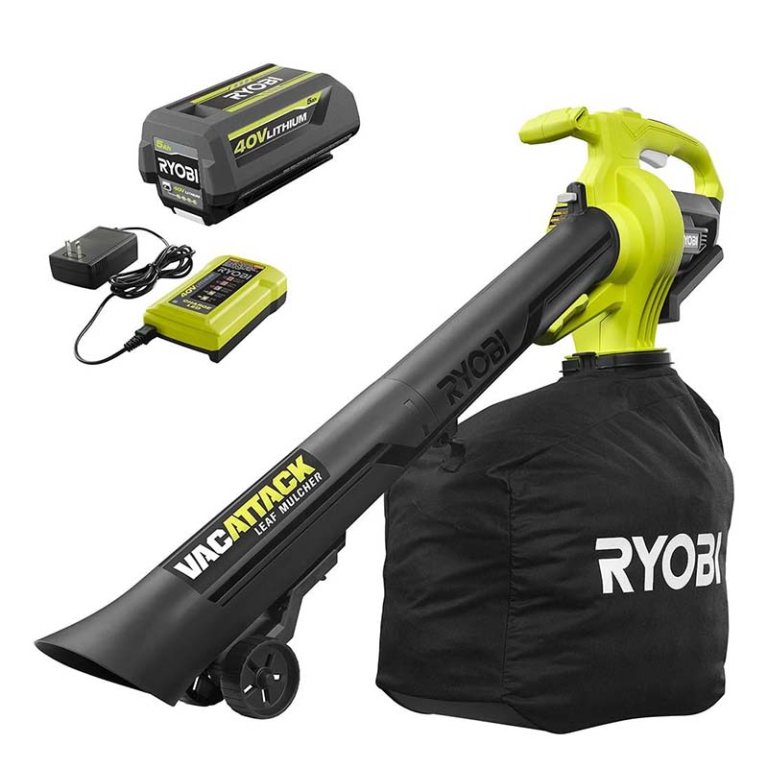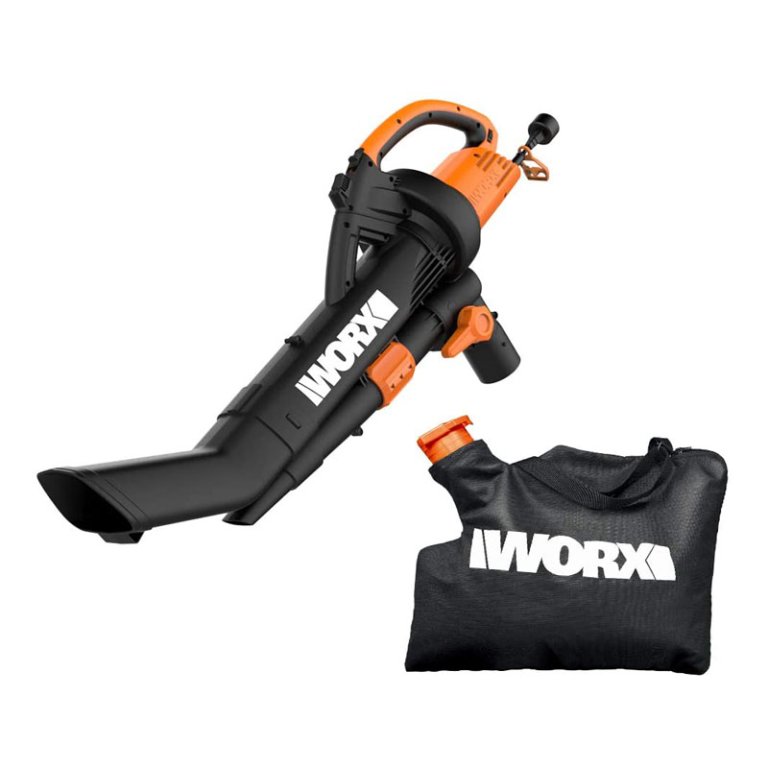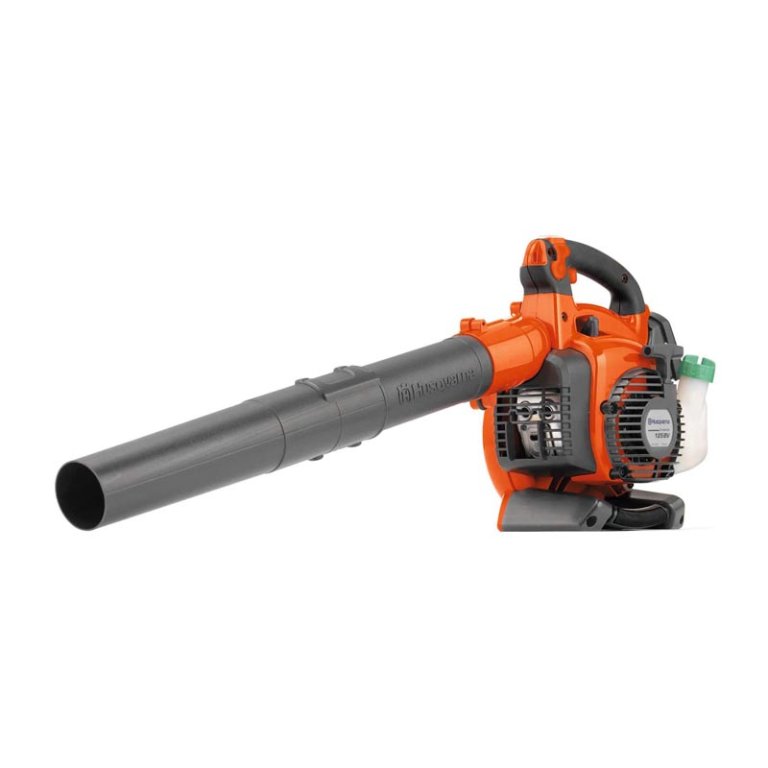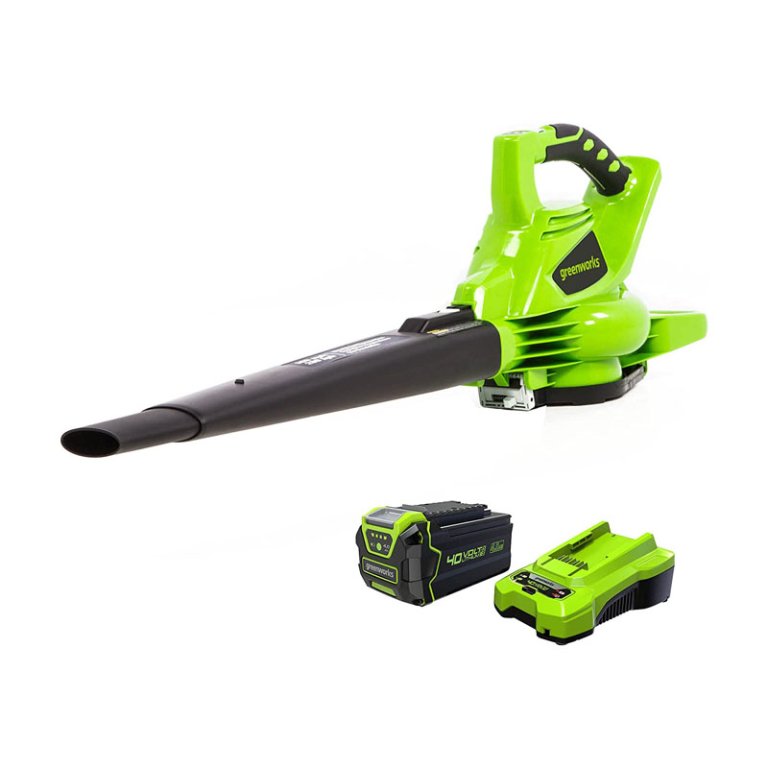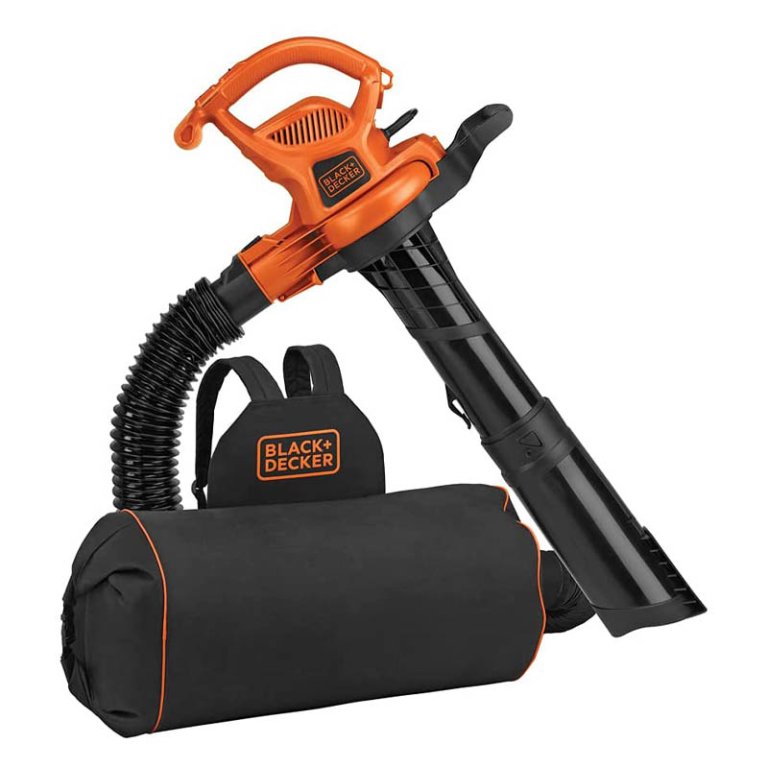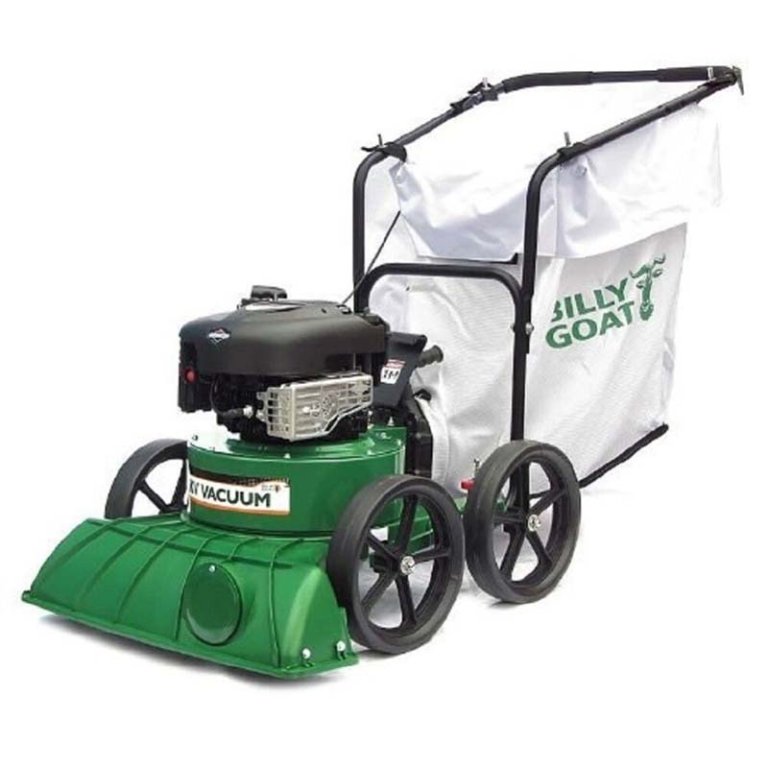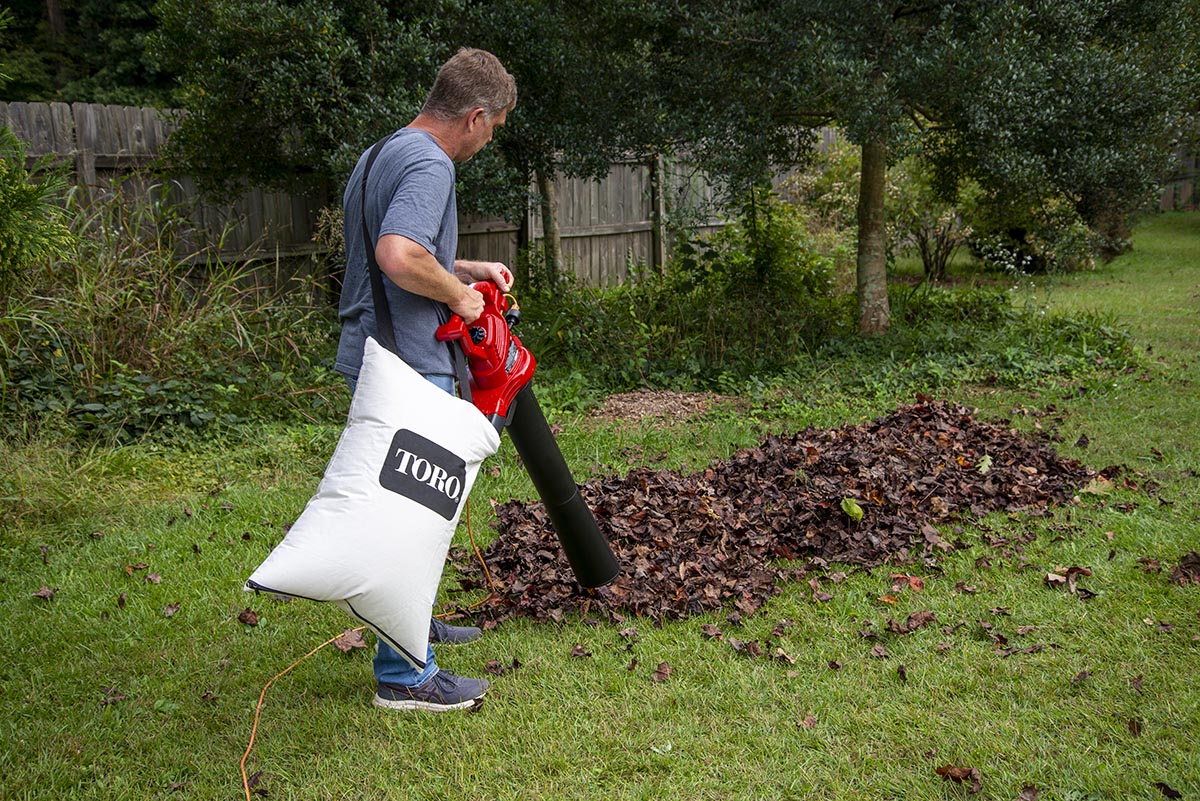
We may earn revenue from the products available on this page and participate in affiliate programs. Learn More ›
Though broadly related to leaf blowers, leaf vacuums operate in the opposite direction. While leaf blowers disperse leaves by pushing air, leaf vacuums suck up fallen foliage through a tube and into a waste bag, operating much like a house vacuum. (A pool leaf vacuum does the same thing for a swimming pool.) Many leaf vacuums also mulch the debris they collect, so folks can use it to benefit the garden.
Leaf vacuums are exceptionally handy for tidying up yards and banishing leaf buildup beneath hedges and around flower beds. To help you find the ideal model, we tested popular gas, electric, and battery-powered leaf vacuums to judge their performance in real-life conditions. We also spoke to Brad Saunders, president of Heroes Lawn Care, which helps homeowners across the country find lawn care experts. “A leaf vacuum is all about convenience,” Saunders says. “If you’re tired of raking up leaves or constantly bending over to gather them after using a blower, a leaf vacuum could be a solution.”
Our top pick is the Toro UltraPlus Electric Leaf Blower Vacuum; it blows, vacuums, and mulches, plus it’s lightweight and powerful to boot. Read on for our reviews of this model and others that we consider to be the best leaf vacuums in various categories and learn the most important considerations to bear in mind while shopping.
- BEST OVERALL: Toro 51621 UltraPlus Electric Leaf Blower Vacuum
↓ Jump to Review - RUNNER-UP: Ryobi 40V Cordless Leaf Vacuum/Mulcher
↓ Jump to Review - BEST BANG FOR THE BUCK: Worx WG509 Trivac 2 Leaf Vacuum With Mulching System
↓ Jump to Review - BEST GAS UNIT: Husqvarna 125BVx Gas Leaf Blower Vacuum
↓ Jump to Review - BEST CORDLESS: Greenworks 24322 40V Cordless Leaf Blower Vacuum
↓ Jump to Review - BEST ELECTRIC: Black+Decker BEBL7000 3-in-1 Electric Leaf Blower
↓ Jump to Review - BEST WALK-BEHIND: Billy Goat KV601SP Lawn and Leaf Vacuum
↓ Jump to Review
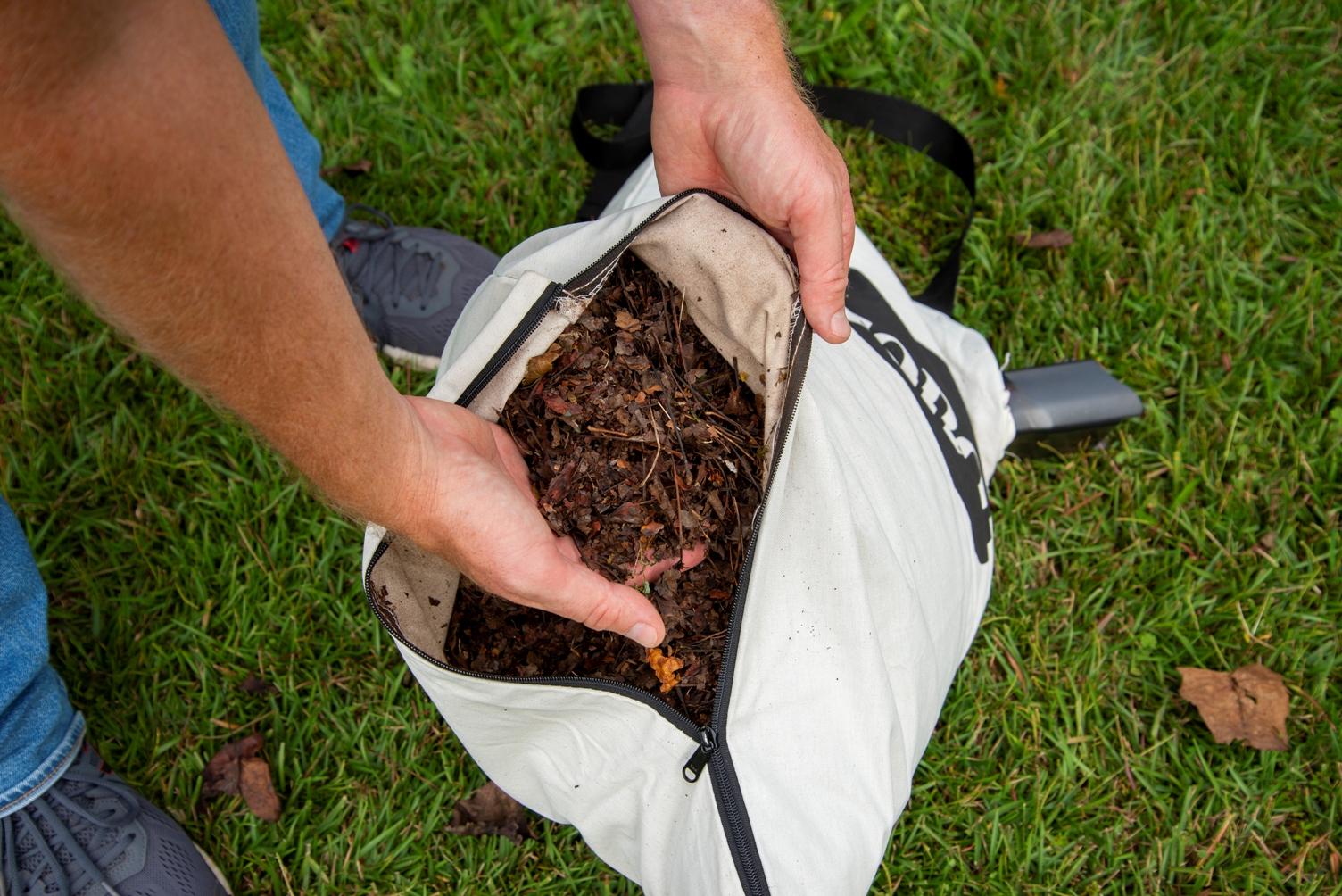
| Testing Stats | |
|---|---|
| Products tested | 8 |
| Time spent testing | 9 hours |
| Tests performed | 4 to 5 |
| Price range | $80 to $1,700 |
Our Top Picks
We narrowed the field of the best leaf vacuum for individual needs by testing several popular models in different categories, with the performance results in the reviews below. (Note: While we tested the Craftsman 25cc 2-Cycle Engine Gas-Powered Leaf Blower, it failed to meet our standards and so was not included in our lineup of recommended models.) Keeping the yard, garage, and flower beds free of fallen leaves can be easier with any of these top picks.
Best Overall
Toro 51621 UltraPlus Electric Leaf Blower Vacuum
What We Like
- 3-in-1 tool: blower, vacuum, and shredding modes
- Lightweight design
- Powerful airflow volume and speed
- Sturdy bag design
- Includes a shoulder strap for carrying
What We Don’t Like
- Requires an outlet for the power cord
- Somewhat clumsy connection for vacuum tube
- Vacuum tube may be uncomfortably long for shorter people to use
Product Specs
- Power source: 12-amp (A) plug-in electric
- Airflow: 410 cubic feet per minute (CFM), 250 miles per hour (mph)
- Weight: 8.9 pounds
Our Ratings: Ease of Use 4.5/5; Performance 4.5/5; Noise 5/5; Value 5/5
The Toro UltraPlus leaf vacuum mulcher is a powerful three-in-one leaf blower, high-speed vacuum, and leaf shredder designed for midsize yards. The 12A electric motor moves up to 410 CFM of air at speeds as high as 250 mph. In vacuum mode, the impeller leaf vacuum shredder grinds to a 16:1 ratio, with 97 percent of shredded debris measuring less than ½ inch in diameter.
In our tests, this plug-in leaf blower with vacuum had no trouble handling loads of leaves—no clogs and only slight hesitation in heavier piles. Moist leaves moved a bit more slowly but were sucked up and ground nonetheless. The lightweight body of this blower vacuum was easy to maneuver, and the vacuum mulcher output was comparable to the others we tested.
In addition to its outdoor vacuum capabilities, this variable-speed unit was just as effective at keeping grass clippings off the driveway and banishing dust and debris from between potted patio plants as it was at clearing fallen leaves. The unique dispersion nozzle blower attachment focused air in a low, wide pattern that reduced dust clouds, but the blow tube did seem a bit too narrow.
Get the Toro leaf vacuum at Amazon or Lowe’s.
Runner-Up
Ryobi 40V Cordless Leaf Vacuum/Mulcher
What We Like
- Adjustable wheel height compatible with different surfaces
- Capable of vacuuming leaves from gravel without disturbing the gravel
- Large leaf bag and 16:1 reduction ratio
- Good for small and midsize yards
- Freedom of movement without a power cord
What We Don’t Like
- Only a yard vacuum and mulcher; does not convert into a leaf blower
- Heavy tool and no shoulder strap
Product Specs
- Power source: 40V 5-amp-hour (Ah) battery
- Airflow: 300 CFM, 75 mph
- Weight: 12.7 pounds
Our Ratings: Ease of Use 3.5/5; Performance 5/5; Noise 5/5; Value 4.5/5
Those with lots of leaves to get rid of might want to consider the Ryobi leaf vacuum and mulcher. This model pulls 300 CFM of air at a maximum speed of 75 mph, processing up to eight bags of leaves per charge. It operates on the Ryobi 40-volt (V) rechargeable battery system, so the 40V 5 Ah battery is shareable among a full line of lawn care power tools for maximum efficiency. It charges in about 2 hours and delivers 12 minutes of runtime per charge. It features a 16:1 mulching reduction ratio, shredding piles of leaves down to just a few bags for easy handling.
In our tests, the Ryobi 40V leaf mulcher did a great job picking up fallen leaves from every surface. Notably, it removed all leaves and pine cones from a gravel area without disturbing the gravel. The battery lasted longer than expected (about 25 minutes of actual working time).
The only complaint we had with this unit was its weight of almost 13 pounds, which was especially cumbersome while dragging a loaded bag. It became tiring after the third work cycle.
What our expert says: “I was able to fill the bagger twice before it was necessary to charge the battery. The long battery life made for efficient clean-up”–Mark Wolfe, Product Review tester and writer
Get the Ryobi leaf vacuum at The Home Depot.
Best Bang for the Buck
Worx WG509 Trivac 2 Leaf Vacuum With Mulching System
What We Like
- Angled tube provides comfortable reach; less back strain
- Easily switches between blower and vacuum modes
- Quick-release bag design
What We Don’t Like
- Not well designed for 2-handed operation
- Slightly awkward power cord position
- Taller users get less benefit from the tube design
Product Specs
- Power source: 12A plug-in electric
- Airflow: 350 CFM, 210 mph
- Weight: 9.3 pounds
Our Ratings: Ease of Use 4.8/5; Performance 4.5/5; Noise 5/5; Value 5/5
The Worx WG509 boasts yard clearing convenience at a budget-friendly price. It changes between its three modes with the flip of a switch; there’s no need to change the tube or use tools to go from blowing to vacuuming. In mulcher mode, a metal impeller reduces leaves in a 18:1 ratio (18 bags to 1 bag). The 1-bushel collection bag includes a shoulder strap to reduce fatigue.
This leaf blower/vac proved to have one of the best designs of any model, at any price. It is the only unit we tested that can change from blower to vacuum without completely reconfiguring the tubes, which made it super easy to work with. It also delivered power comparable to models costing twice as much. It did clog on some coarse debris, but it performed well overall.
The model only has two speeds, but it reaches a top speed of 210 mph with 350 CFM. An ergonomic tube design reduces back strain by putting the tube at a parallel angle to the ground. The angle also helps it reach under and around landscaping elements.
Get the Worx leaf vacuum at Amazon or The Home Depot.
Best Gas Unit
Husqvarna 125BVx Gas Leaf Blower Vacuum
What We Like
- Cruise control and anti-vibration technology
- Soft-grip handle with easily accessed controls
- Shoulder strap allows for more comfortable use
- Cordless design
What We Don’t Like
- Somewhat awkward rigid bag tube and clumsy tube conversion
- Requires mixed gas
Product Specs
- Power source: 28 cubic centimeter (cc) 2-cycle gas engine
- Airflow: 425 CFM, 170 mph
- Weight: 9.6 pounds
Our Ratings: Ease of Use 5/5; Performance 4/5; Noise 4/5; Value 4/5
For large gardens and heavy leaf accumulation, it’s hard to beat the Husqvarna gas leaf blower vacuum, which draws in air at speeds of up to 170 mph and features an air volume of 425 CFM. Its easy-crank engine enables quick starting, and an auto-return stop switch automatically resets the vacuum for simpler starting. It also features cruise control for easier handling and less hand fatigue.
After fueling up with a 50:1 mix of gasoline to 2-cycle oil, the Husqvarna engine started easily with just two pulls. Powerful air movement at the suction tube easily pulled in piles of leaves, and the tube remained unclogged, even when pulling in wet debris. The mulching knives aggressively shredded twigs as well as leaves without a problem. The only issue we experienced was the slightly awkward feel of the curved tube that feeds the bag with shredded leaves.
Though the unit weighs in at 9.6 pounds, a shoulder strap helps support the vacuum to reduce arm fatigue. The Husqvarna also features anti-vibration technology to reduce hand stress.
Get the Husqvarna leaf vacuum at Amazon or Lowe’s.
Best Cordless
Greenworks 24322 40V Cordless Leaf Blower Vacuum
What We Like
- Cordless model with good suction power
- Works well on wet leaves
- Fairly good runtime per charge
- Ideal for moderate yard sizes
- Toolless transition from blower to vacuum
What We Don’t Like
- Additional battery may be necessary to avoid downtime
- Suction tube may clog with coarse debris
- Higher price than plug-in and gas models
Product Specs
- Power source: 40V 4 Ah rechargeable battery
- Airflow: 340 CFM, 185 mph
- Weight: 8.6 pounds
Our Ratings: Ease of Use 4/5; Performance 4/5; Noise 5/5; Value 3.5/5
If a property is too large for a corded leaf vacuum, but mixing fuel for a gas model is too much hassle, check out this battery-powered option from Greenworks. Its 12A lithium-ion battery (included along with the charger) powers the vacuum’s brushless motor to run up to 60 minutes on a single charge at the lowest setting.
This cordless leaf blower/vacuum offers good suction and shredding capability. The runtime was longer than many comparable battery-powered blower/vacuum models. But still, at about 20 minutes per charge on high speed, in an average-size yard with lots of leaves, users will either need to have a second battery charged and ready to vacuum after blowing, or they will have to stop and recharge at some point in the project.
The vacuum draws in air at six speed options up to 185 mph, with an airflow volume of 340 CFM, which is suitable for light to moderate leaf accumulation. A metal impeller breaks up leaves for mulching before depositing them in the collection bag. A bigger battery puts the weight at 8.6 pounds, so you’ll need some strength for longer jobs.
Get the Greenworks leaf vacuum at Amazon or Walmart.
Best Electric
Black+Decker BEBL7000 3-in-1 Electric Leaf Blower
What We Like
- Convenient backpack-style collection bag distributes weight evenly
- Good suction power
- Great for gathering large or wet leaves
- Zipperless collection bag allows for simple emptying
What We Don’t Like
- Slightly awkward switch placement
- Power cord sometimes slips out
- Screwdriver required to switch from blower to vacuum
Product Specs
- Power source: 12A plug-in electric
- Airflow: 400 CFM, 250 mph
- Weight: 11.1 pounds
Our Ratings: Ease of Use 4/5; Performance 3/5; Noise 5/5; Value 4/5
This Black+Decker three-in-one electric leaf vacuum boasts a backpack design that lets you avoid lurching sideways with a loaded bag of leaves. Balancing the weight across both shoulders and being able to walk naturally makes yard work less awkward and more comfortable, especially during bigger jobs. The 12A motor in this backpack leaf sucker/blower pushes 400 CFM of air up to 250 mph, and the blower unit weighs in at 11.1 pounds.
This blower was not the lightest or the most powerful of the test group, but it performed well and excelled in user comfort. The backpack feature and flexible debris tube relieved the added weight (just over 2 pounds heavier than the lightest model we tested). As the bag filled, the benefit of a balanced load became even more pronounced. The only drawback was that the positions of the power cord and on/off switch were not as convenient in vacuum/backpack mode.
Vacuuming, mulching, and blowing performance for this unit were average compared with the test group. However, those with larger yards or limited endurance may appreciate the improved balance and comfort of working with a backpack-style tool.
Get the Black+Decker leaf vacuum at Amazon, The Home Depot, or Walmart.
Best Walk-Behind
Billy Goat KV601SP Lawn and Leaf Vacuum
What We Like
- Powerful airflow and wide intake
- Large no-zipper debris bag reduces downtime for dumping
- Self-propelled rear-wheel drive works on flat or hilly terrain
- Variable-height adjustment for working on grass or hard surfaces
- Also picks up twigs, pine cones, acorns, and other plant debris
What We Don’t Like
- Bulky machine takes up a considerable amount of storage space
- Hose kit accessory with telescoping handle is not included
Product Specs
- Power source: 190cc gas engine
- Airflow: 1,707 CFM
- Weight: 132 pounds
Our Ratings: Ease of Use 4/5; Performance 4/5; Noise 4/5; Value 3/5
For larger properties with lots of trees and a mix of grassy and hard surfaces to maintain, a walk-behind leaf vacuum could be the best machine for the job. The Billy Goat KV601SP self-propelled lawn and leaf vacuum features a wide nozzle with powerful suction and an oversize bagger to clean large areas quickly with less downtime emptying.
This walk-behind leaf vacuum comes equipped with a 190cc Briggs & Stratton gas engine that delivers a whopping 1,707 CFM of airflow through the 26-inch nozzle and powers the rear drive wheels. A serrated impeller grinds dry leaves and debris at a 12:1 reduction ratio before sending it to the 4-bushel bagger. The heavy-duty zipperless bagger uses a clip closure for fast debris removal.
This machine includes an adjustable-height nozzle to capture different types of debris, including leaves and pine needles, pine cones, acorns, flower petals, and more. It works well on a variety of surfaces, such as grass, gravel, mulch, and pavement. An optional hose kit (sold separately) expands the vacuum’s functionality to include debris that lands on hedges, between shrubs, and in other hard-to-reach areas.
Our walk-behind leaf vacuum test included a heavy layer of leaves, clumpy grass clippings, twigs, pine needles and pine cones on grass and concrete. The Billy Goat rolled along and picked up everything in its path. Matted wet foliage sometimes required a second pass, and longer sticks partly blocked the nozzle a couple of times, but the impeller never became clogged and the bagger held an impressive amount of material.
In the absence of a blower to remove litter from hard-to-reach spots, we would have appreciated the hose attachment to access these pesky areas. Still, this was far and away the fastest and most thorough tool for the job.
Get the Billy Goat leaf vacuum at Amazon, Lowe’s, Acme Tools, or Mowers at Jacks.
Jump to Our Top Picks
How We Chose and Tested the Best Leaf Vacuums
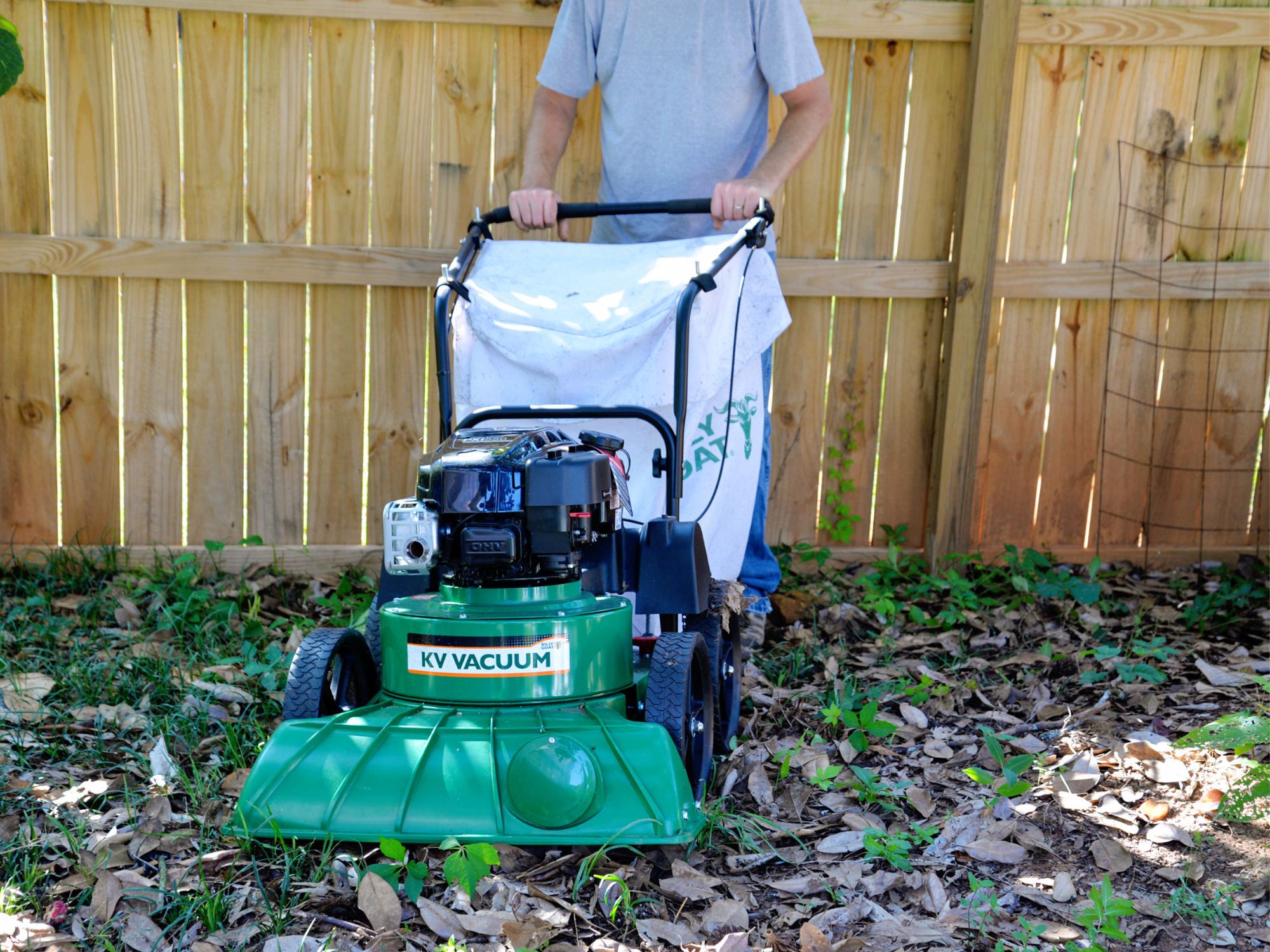
To gauge the functionality of these devices, we set up a leafy test course that gave each tool a fair trial in a real-world setting. We used each tool in both of its configurations, blower and vacuum, to see how it could build leaf piles and then vacuum/mulch them. The debris included recently fallen leaves from the current year as well as old, built-up debris that had accumulated beneath shrubs over the course of a full year.
The models reviewed in this guide passed the test by adequately blowing out the heavily accumulated debris, gathering the recently fallen leaves, and grinding up a mixed pile. However, they all worked more slowly with wet material and were also somewhat subject to clogging if the suction nozzle was forced directly into the pile without adequate air space at the edges.
What to Consider When Choosing a Leaf Vacuum
Leaf vacuums come in various types and with different-size collection bags. There are also three power source types—gas, electric, and battery power—with each option affecting runtime and suction. Take a look below at some important factors to help determine the motor type, power, and design that will work best for you.
Type
Leaf vacuums are made in a few types, and some kinds work better in certain situations and setups than others.
- Handheld leaf vacuums are the smallest and least powerful option, but they’re often the most affordable and lightest. These models can be vacuum only or a hybrid that works as a blower and/or sweeper too. While handhelds typically have the smallest collection bags, some models may cross into backpack territory (see below) and have somewhat larger vacuum bags. A cordless leaf vacuum is also typically handheld to provide optimal maneuverability.
- Backpack leaf vacuums are usually hybrid models that have leaf blowing as their main function. Backpack models tend to have larger collection sacks than handheld models that need emptying less often.
- Walk-behind leaf vacuums resemble lawn mowers, but instead of cutting grass, they suck leaves up into a large collection sack. These models hold the most leaves and may include a mulch function as well. However, they’re more expensive and cannot be used as a leaf blower.
Electric vs. Gas
Like lawn mowers, leaf vacuums are available in electric- and gas-powered versions.
- Electric leaf vacuums are quieter, easier to maintain, and typically less expensive. Corded leaf vacuums are best suited to modestly sized outdoor spaces since they require access to an electrical outlet. A cordless leaf vacuum blower with rechargeable batteries allows room to roam and is compact enough to be easily stored. However, they don’t match the power of other leaf vacuums and can only be used for relatively brief periods of time between charges. Saunders likes electric leaf vacuums: “They’re quieter, which means you’re not going to be that neighbor everyone complains about. Plus, you don’t have to mess around with gas or oil changes—just plug it in, or charge up a battery if you’re going cordless, and you’re ready to go.”
- Gas-powered leaf vacuums offer greater power and the ability to cover lots of ground in one go. As a result, these models are often more expensive. Gas leaf vacuums also run loud, emit fumes, and require maintaining the proper gas-to-oil ratio.
Power
To figure out the power of a leaf vacuum, check the product description for two numbers: mph and CFM. The mph stands for miles per hour—in this case, referring to how quickly air is suctioned into the unit and through the tube. Most units run between 110 and 180 mph, although some may reach extremes of 250 mph or so.
Somewhat more important than airspeed, however, is CFM. This describes how much air moves through the vacuum in the span of 60 seconds, indicating how powerful the unit is. While mph provides an idea of how quickly leaves can go through the tube, CFM indicates how much can go through all at once.
The CFM rankings for leaf vacuums range from between 150 to 600. A unit with a CFM under 200 may be all that’s needed to clean up an apartment balcony or a small yard, but for larger areas, it may be desirable to invest in a unit with higher CFM.
Saunders recommends a leaf vacuum with a strong motor “that can really get the job done.” He adds, “Something like a 12-amp electric motor, which you’ll find in some top models, will give you the suction power you need to handle a good amount of leaves without getting bogged down.”
Runtime
The runtime of a battery-powered leaf vacuum can limit the amount of work that can be done. Most models offer at least 20 to 30 minutes of runtime on the highest power levels. At lower levels, the battery may run for 45 minutes or more.
Battery-powered models that include two or more interchangeable batteries can increase the available work time. While one battery is in use, the other battery charges. Charge times vary from 1.5 to 3 hours and sometimes longer depending on the battery size. The amount of work may still be limited with interchangeable batteries, but it will provide more work time than a single battery.
Some manufacturers provide batteries that are interchangeable with the brand’s other power tools. In these cases, buying power tools of the same brand can add to the number of batteries available. Ultimately, that can extend possible work time even more.
Versatility
Some leaf vacuums offer bells and whistles beyond simple suction. In fact, most vacuums these days are actually leaf blowers with a vacuum function. That provides extra use options with a single tool.
Leaf vacuums are best suited for smaller outdoor spaces, like those surrounding garden apartments and duplexes. Some models also offer a mulching option, which is great for repurposing leaves into healthy plant beds.
Ease of Use
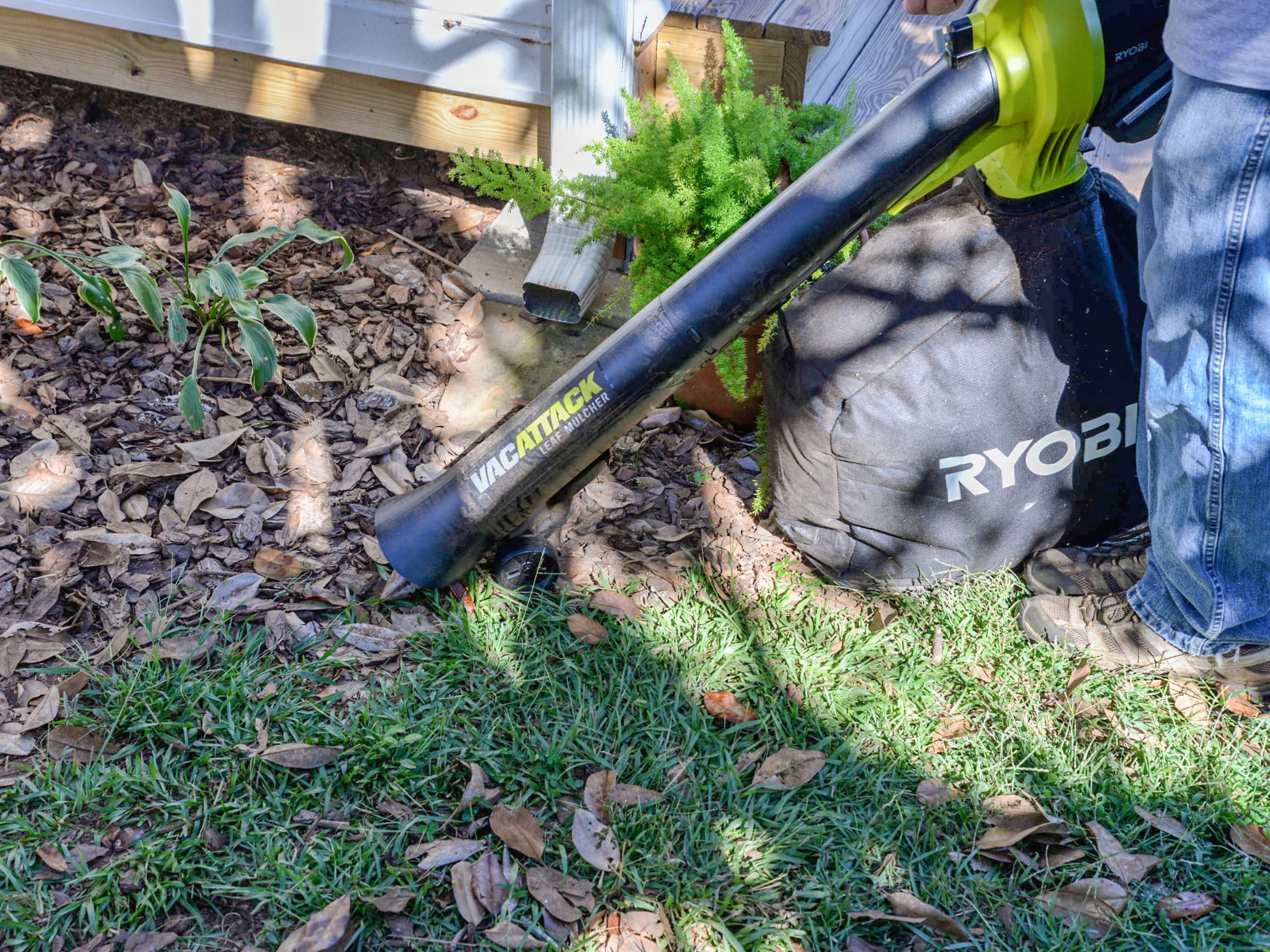
A leaf vacuum’s mix of features and design can make it easier or harder to use. Bag size, for example, determines how often it will need to be emptied. Larger bags mean less frequent emptying, but they can be awkward and heavy to carry.
Weight also affects ease of use. Gas-powered leaf vacuums weigh the most, though some battery-powered models are almost as heavy. For those with a large yard, gas power makes sense because it can keep a consistent high power throughout the whole yard.
However, for those with smaller yards, the light weight of a handheld or a battery-powered model can be more comfortable. Models with a backpack bag combine the lighter weight of a handheld leaf vacuum with the convenience of a backpack.
Ergonomics is also something to take into consideration. “You’re going to be using this tool for a while, so it needs to be comfortable,” Saunders says. “Lightweight models are easier on the arms and back, especially if you’re working in a large yard. Features like an ergonomically designed tube can also make a big difference by reducing strain.”
Finally, there are controls to consider. Trigger switches and on/off buttons directly on the handle are easier to use. This allows you to turn the machine on or off with one hand. Toolless conversion for hybrid models can also add to ease of use.
FAQs
Leaf vacuums aren’t complicated once you understand how they work and what features are needed for specific jobs. However, since they aren’t as common as leaf blowers, you might still find yourself scratching your head as you look at the specs. Here, we answer some of the most common questions about leaf vacuums to help you make the right choice.vice. Some models require nothing more than the flip of a switch. Others require extra tools to remove a blow tube before functioning as a vacuum. Check the owner’s manual for specific instructions.
Handheld leaf vacuums work best for small yards and few leaves. Once the dry or wet leaves start piling up, a backpack or an electric model will offer longer running times and a larger collection-bag capacity. Gas leaf vacuums also work well for large yards, though they do require more maintenance and can be heavy.
Look at the leaf vacuum’s mph and CFM when determining the power. While these measurements aren’t volts or amps, they are a better indicator of the quantity of leaves the vacuum can handle. Speeds of anywhere between 110 to 220 mph are usually adequate for leaf removal equipment.
The CFM tells you the quantity of dry or wet leaves the vacuum can move at once. Higher numbers (at 200 or higher) mean more powerful suction and removal. However, a model with a well-designed tube can provide adequate suction at 95 CFM and above.
A lawn vacuum can pick up grass clippings. However, depending on its power and CFM, it may struggle with wet clippings.
Although the angle of use is not quite right, it is possible to clean gutters with a leaf vacuum. However, a leaf vacuum may not have the power to remove wet leaves.
The process of switching from blower to vacuum depends on the make and model of the device. Some models require nothing more than the flip of a switch. Others require extra tools to remove a blow tube before functioning as a vacuum. Check the owner’s manual for specific instructions.
Yes, leaf vacuums can definitely be noisy, but the noise level depends on the model. Some models can reach levels into the 90 decibel range. Reduce your risk of hearing damage by wearing ear protection while using a leaf vacuum.
It’s necessary to clean a few different parts of a leaf vacuum. Clean the air filter with a gentle brush or blow compressed air through it. You’ll want to machine wash the collection bag periodically, clean the fan blades, and remove dirt and debris from the impeller housing.
With proper maintenance, most leaf vacuums will last between 5 and 8 years.
There is a huge range in cost, with some models selling for under $100 while others boasting a price tag of over $1,000. It’s possible to get an effective and powerful leaf vacuum for a few hundred dollars, however.
Why Trust Bob Vila
Bob Vila has been America’s Handyman since 1979. As the host of beloved and groundbreaking TV series including “This Old House” and “Bob Vila’s Home Again,” he popularized and became synonymous with “do-it-yourself” home improvement.
Over the course of his decades-long career, Bob Vila has helped millions of people build, renovate, repair, and live better each day—a tradition that continues today with expert yet accessible home advice. The Bob Vila team distills need-to-know information into project tutorials, maintenance guides, tool 101s, and more. These home and garden experts then thoroughly research, vet, and recommend products that support homeowners, renters, DIYers, and professionals in their to-do lists.
Meet the Tester
Mark Wolfe is a writer and product tester with a background in the nursery and landscaping industry. For more than 20 years he mowed, edged, planted, pruned, cultivated, irrigated, and renovated beautiful landscapes. Now he tests and writes reviews about the latest outdoor power equipment, hand tools, lawn care products, and other outdoor living goods.
Additional research provided by Glenda Taylor and Stacey L. Nash.
